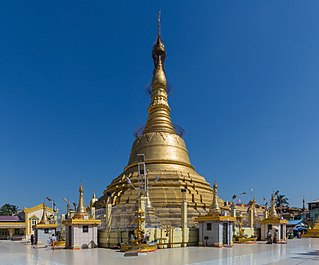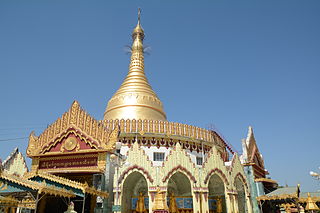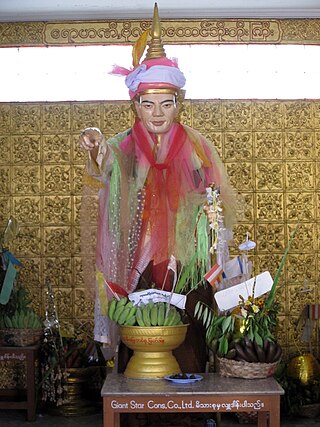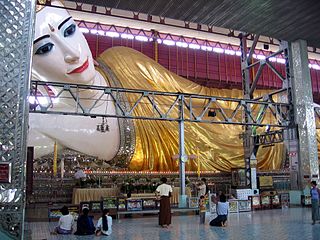
The Shwedagon Pagoda, officially named Shwedagon Zedi Daw, and also known as the Great Dagon Pagoda and the Golden Pagoda, is a gilded stupa located in Yangon, Myanmar.

Kyaiktiyo Pagoda is a well-known Buddhist pilgrimage site in Mon State, Myanmar. It is a small pagoda built on the top of a granite boulder covered with gold leaves pasted on by its male worshippers.

The Sule Pagoda is a Burmese Buddhist stupa located in the heart of downtown Yangon, occupying the centre of the city and an important space in contemporary Burmese politics, ideology and geography. According to legend, it was built before the Shwedagon Pagoda during the time of the Buddha, making it more than 2,600 years old. Burmese legend states that the site for the Shwedagon Pagoda was asked to be revealed from an old nat who resided at the place where the Sule Pagoda now stands.

The Botataung Kyaik De Att Pagoda is a famous pagoda located in downtown Yangon, Myanmar, near the Yangon river. The pagoda was first built by the Mon around the same time as was Shwedagon Pagoda—according to local belief, over 2500 years ago, and was known as Kyaik-de-att in Mon language. The pagoda is hollowed within, and houses what is believed to be a sacred hair of Gautama Buddha.

Phaung Daw U Pagoda, also spelt Phaung Daw Oo or Hpaung Daw Oo, is a notable Buddhist pagoda in Myanmar, located in the village of Ywama on Inle Lake in Shan State. The pagoda is the site of a major annual pagoda festival during which the temple's principal Buddha images are circulated on a royal barge across Inle Lake.

The Shaitthaung Temple, also spelled Shitthaung according to Standard Burmese pronunciation, is a famous Buddhist temple in Mrauk U. The name means 'Temple of 80,000 Buddha Images', and is also known as the 'Temple of Victory'.

Htukkanthein is one of the most famous Buddhist temples in the ancient Arakanese city of Mrauk U, in Rakhine State, Western Myanmar. The name means "Cross-Beam Ordination Hall".

Kaba Aye Pagoda, formally Thiri Mingala Gaba Aye Zedidaw, သီရိမင်္ဂလာကမ္ဘာအေးစေတီတော်), is a Buddhist pagoda located on Kaba Aye Road, Mayangon Township, Yangon, Myanmar. The pagoda was built in 1952 by U Nu in preparation for the Sixth Buddhist Council that he held from 1954 to 1956. The pagoda measures 111 feet (34 m) high and is also 111 feet (34 m) around the base. The pagoda is located approximately 11 km north of Yangon, a little past the Inya Lake Hotel. The Maha Pasana Guha was built simultaneously with the Kaba Aye Pagoda and is located in the same complex. The cave is a replica of the Satta Panni cave, located in India, where the First Buddhist Synod was convened. The six entrances of The Maha Pasana Cave symbolize the Sixth Great Synod. The cave is 455 feet (139 m) long and 370 feet (110 m) wide. Inside, the assembly hall is 220 feet (67 m) long and 140 feet (43 m) wide.

Bo Bo Gyi traditionally refers to the name of a guardian deity unique to each Burmese Buddhist temple or pagoda. Bo Bo Gyi is typically depicted as a nearly life-sized elderly man, dressed in a curved cap and sometimes carrying a cane, to signify old age. Offerings of scarves and paso are common by worshipers. There are many Bo Bo Gyi shrines throughout the country, and some are more widely respected than others. The Shwenyaungbin Bo Bo Gyi shrine between Yangon and Bago is often visited by new car owners hoping to have their cars blessed by the Bo Bo Gyi spirit at that site.

Shin Upagutta is an arahant commonly venerated by Buddhists in Myanmar. He is believed to protect worshipers from danger, including floods and storms. He is also venerated in Cambodia, Northern Thailand and Laos, where he is known as Upakhut.

The Kaunghmudaw Pagoda is a large Buddhist pagoda on the northwestern outskirts of Sagaing in central Myanmar (Burma). Modeled after the Ruwanwelisaya pagoda of Sri Lanka, the Kaunghmudaw is known for its egg-shaped design, which stands out among more traditional-style, pyramid-shaped Burmese pagodas. The stupa's formal name Yaza Mani Sula signifies the enshrinement of Buddhist relics inside its relic chamber. But it is commonly known by its popular name, Kaunghmudaw. It is an important pilgrimage and tourist destination in the Sagaing area.

Maha Bodhi Ta Htaung is a Buddhist religious complex located in Monywa Township, Sagaing Region, Myanmar (Burma). It is known for the Giant Standing Buddha statue, the third tallest in the world, and for the Great Attitudes of U Narãda, who built the monastery. This Sāsana (religious) site contains thousands of Buddha statues beneath thousands of Bo trees, the Giant Reclining Buddha Statue, Aung Sekkya Stupa, and other large Buddha statues. Currently, a Sitting Buddha Statue, which is expected to become the world's largest Sitting Buddha Statue, is in construction. Many Buddhist monks can study the Buddhist Pariyatti literature at the monastery. Moreover, meditation centres or Vipassãnā centres are opened at this monastic site both for monks and laypersons.

Lumbini Natural Park is a Buddhist temple located at Desa Dolat Rayat, Berastagi in North Sumatra, Indonesia. It was inaugurated with a great ceremony in October 2010. The ceremony was attended by more than 1,300 monks and more than 200 lay people from around the world. Taman Alam Lumbini is a replica of Shwedagon Pagoda in Yangon, Myanmar. The architecture is similar to a Myanmar pagoda, covered in gold. It hosts an elephant statue and the door appears like a Burmese craft.

Chaukhtatgyi Buddha Temple is the most well-known Buddhist temple in Bahan Township, Yangon, Yangon Region, Myanmar. It houses one of the most revered reclining Buddha images in the country. The Buddha image is 66 metres (217 ft) long, and one of the largest in Burma.
The architecture of Myanmar, in Southeast Asia, includes architectural styles which reflect the influence of neighboring and Western nations and modernization. The country's most prominent buildings include Buddhist pagodas, stupas and temples, British colonial buildings, and modern renovations and structures. Myanmar's traditional architecture is primarily used for worship, pilgrimage, storage of Buddhist relics, political activism and tourism.

Nagayon Pagoda is a Buddhist temple in Amarapura, a former royal capital in Mandalay Region, Myanmar (Burma). The temple was built by Anauk Nanmadaw Ma Mya Lay, the Queen of the Western Palace during the reign of Bagyidaw, during the first half of the 1800s. The temple's exterior is known for its unusual design. The roof of the temple is draped by the naga Mucalinda, who is said in Buddhist mythology to have protected the Buddha from the elements while achieving enlightenment.

The Myazigon Pagoda is a Buddhist temple in Taungoo, Myanmar. Built in either the 16th or 19th century, the temple contains several images of members of the Toungoo dynasty and a large sitting bronze statue of the Buddha that was captured in a Toungoo war against the Ayutthaya Kingdom.

The Uzina Pagoda, also known as the U Zina Pagaoda, is a Buddhist temple in Mawlamyine, Mon State, Myanmar. Built in the 19th century, the temple contains hairs allegedly from the Buddha, and contains several sculptures symbolizing scene's from the Buddha's life. The temple itself is often associated with gemstones and wish fulfillment.
Kyaik Ne Yay Lae Pagoda(Burmese: ဆံတော်ရှင်ကျိုက်နဲ ရေလယ်ဘုရား) is a Buddhist pagoda located in the mid of ocean in Wekalaung village of Thanbyuzayat township in Mon state of Myanmar. The pagoda can be reached on foot via 1.6 miles (2.6 km) long ridge when the tide is low. When tide becomes high, the pagoda is disconnected from the local village. The pagoda is visited by Buddhist pilgrims mainly on the second full of Tan Saung Mon. It is believed that the blessings of The Buddha helps to reduce the flow and open the way for the pilgrims to the pagoda. The pagoda was built by King Thirimathaka.
























